1998 | OriginalPaper | Buchkapitel
Kondratiev’s Trip Overseas, 1924-25
verfasst von : Vincent Barnett
Erschienen in: Kondratiev and the Dynamics of Economic Development
Verlag: Palgrave Macmillan UK
Enthalten in: Professional Book Archive
Aktivieren Sie unsere intelligente Suche, um passende Fachinhalte oder Patente zu finden.
Wählen Sie Textabschnitte aus um mit Künstlicher Intelligenz passenden Patente zu finden. powered by
Markieren Sie Textabschnitte, um KI-gestützt weitere passende Inhalte zu finden. powered by
As befits a scholar of international standing, Kondratiev went on a long journey overseas during 1924-25 to visit institutions and individuals with similar interests as NKZem and the Conjuncture Institute. The idea of this trip was first proposed at a meeting of the Presidium of Zemplan on 15 November 1922, and final permission was granted by the People’s Commissar of Agriculture A.P. Smirnov on 8 March 1924. Kondratiev was allocated 4000 rubles in order to spend one month in Germany, two months in the UK, and two months in the USA.1 This trip was important to Kondratiev’s intellectual development as it gave him direct contact with those economists who he had previously encountered only in print, such as Irving Fisher and John Maynard Keynes, and enabled him to study relevant institutions such as the US Department of Agriculture directly. This trip also gave Kondratiev’s theoretical work an important boost by enabling him to discuss the idea of long cycles with the world’s leading business cycle economist, Wesley Mitchell. In personal terms the trip must have been significant, enabling Kondratiev to see first-hand the economic systems of some of the most advanced countries in the world and to use his knowledge of English and German. According to Efimkin, during the trip several American universities offered Kondratiev the opportunity to stay in the USA and take up professorships.2 Since Kondratiev rejected these offers it can only be assumed that he believed, at least in 1924, that NEP was indeed meant seriously and for a long time.
